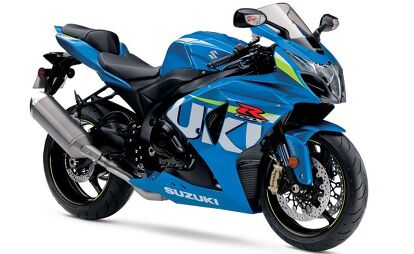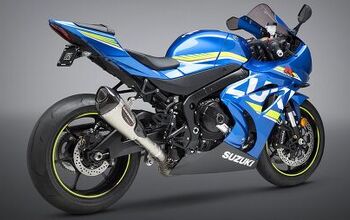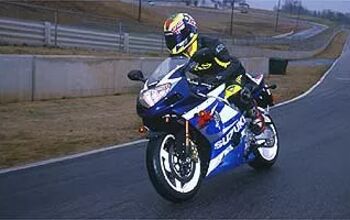Suzuki Adds ABS To 2015 GSX-R1000

For the 2015 model year, Suzuki has added ABS to the venerable GSX-R1000. Though the move was likely to comply with European regulations requiring all new motorcycles to come equipped with the feature, its addition is a welcome sight, especially for street riders.
The Antilock Brake System monitors wheel speeds to match stopping power to the available traction. This helps prevent wheels from locking up due to hard braking or to changes in road conditions, and enhances brake performance. This lightweight ABS package is based on a proven Suzuki system, but is built specifically for the GSX-R1000. Front disc brakes feature Brembo radial-mount monoblock calipers to deliver exceptional stopping power. The rear disc brakes uses a Nissin caliper mounted above the swingarm; its compact design contributes to a reduction of unsprung weight.
The GSX-R1000’s new Suzuki Racing Blue bodywork and graphics treatment salutes Suzuki’s long-running passion for racing, and the return to MotoGP competition for 2015. And this GSX-R1000 is about more than just ABS and new graphics.
Key Features of the Suzuki GSX-R1000 ABS:
Engine
- 999cc 4-cylinder powerplant has a bore x stroke of 74.5mm x 57.3mm to bring enhanced throttle response across the entire rpm range and provide superior potential for racetrack performance.
- Optimized camshaft profiles further enhance racing potential and were developed using proven MotoGP racing engine technology.
- Optimally shaped hemispherical combustion chambers and a compression ratio of 12.9:1 promote low-range and mid-range performance and help achieve a broad torque curve.
- Precision-manufactured 12-hole fuel injectors produce a fine fuel mist for more complete combustion.
- Suzuki Composite Electrochemical Material (SCEM)-plated cylinders integrated into the upper crankcase reduce friction and improve heat transfer, durability and ring seal.
- The unique Suzuki Drive Mode Selector (S-DMS) system allows the rider to choose different fuel-injection and ignition-system maps, adjusting power delivery to suit personal preferences using a button on the left handlebar switch assembly.
- Pentagonal shaped ventilation holes in the sides of each cylinder bore reduce pumping losses normally caused by internal crankcase air-pressure resistance to downward piston movement.
- The 4-2-1 exhaust system carries a Suzuki Exhaust Tuning (SET) valve maximizing torque and throttle response, especially in the low-to-mid rpm range.
Chassis, Transmission - Rear shock absorber features adjustable rebound damping and spring pre-load with the fine tuning of both high-speed and low-speed compression damping.
- Front and rear radial tires feature specially design tread patterns with low-mass, multi-belt carcasses for sharp handling and low weight.
- Electronically controlled steering damper provides lighter steering at slower speeds and more damping force at racetrack and highway speeds.
- Race-proven back-torque-limiting clutch contributes to smoother downshifting and corner entry.
- The six-speed close-ratio transmission uses vertically staggered shafts to reduce overall engine length.

Troy's been riding motorcycles and writing about them since 2006, getting his start at Rider Magazine. From there, he moved to Sport Rider Magazine before finally landing at Motorcycle.com in 2011. A lifelong gearhead who didn't fully immerse himself in motorcycles until his teenage years, Troy's interests have always been in technology, performance, and going fast. Naturally, racing was the perfect avenue to combine all three. Troy has been racing nearly as long as he's been riding and has competed at the AMA national level. He's also won multiple club races throughout the country, culminating in a Utah Sport Bike Association championship in 2011. He has been invited as a guest instructor for the Yamaha Champions Riding School, and when he's not out riding, he's either wrenching on bikes or watching MotoGP.
More by Troy Siahaan
































Comments
Join the conversation